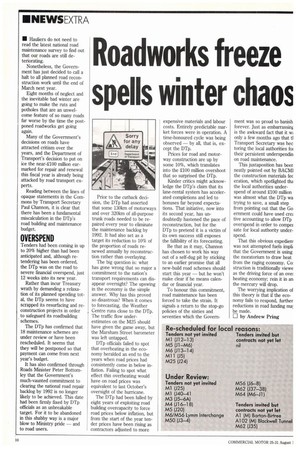Roadworks freeze spells winter chaos
Page 8

If you've noticed an error in this article please click here to report it so we can fix it.
Prior to the cutback decision, the DTp had asserted that some 130km of motorways and over 320Icm of all-purpose trunk roads needed to be repaired every year to eliminate the maintenance backlog by 1992. It had also set as a target its reduction to 10% of the proportion of roads renewed annually by reconstruction rather than overlaying.
The big question is: what has gone wrong that so major a commitment to the nation's transport requirements can disappear overnight? The upswing in the economy is the simple answer. Why has this proved so disastrous? When it comes to forecasting, the Weather Centre runs close to the DTp. The traffic flow underestimates on the M25 should have given the game away, but the Marsham Street barometer was left untapped.
DTp officials failed to spot that overheating in the economy heralded an end to the years when road prices had consistently come in below inflation. Failing to spot what effect this overheating would have on road prices was equivalent to last October's oversight of the hurricane.
The DTp had been lulled by eight years of exploiting road building overcapacity to force road prices below inflation, but from the start of the year tender prices have been rising as contractors adjusted to more expensive materials and labour costs. Entirely predictable market forces were in operation. A time-honoured cycle was being observed — by all, that is, except the DTp.
Prices for road and motorway construction are up by some 10%, which translates into the £100 million overshoot that so surprised the DTp.
Kinder critics might acknowledge the DTp's claim that its lane-rental system has accelerated completions and led to bonuses far beyond expectations. That initiative, now into its second year, has undoubtedly hastened the pace of reconstruction, but for the DTp to pretend it is a victim of its own success still exposes the fallibility of its forecasting.
Be that as it may, Channon has chosen to work his way out of a self-dug pit by sticking to an earlier promise that all new-build road schemes should start this year — but he won't make clear if he means calendar or financial year.
To honour this commitment, road maintenance has been forced to take the strain. It signals a return to the stop-go policies of the sixties and seventies which the Govern ment was so proud to banish forever. Just as embarrassini is the awkward fact that it w; only a few months ago that tl Transport Secretary was hec toting the local authorities foi their persistent underspendin on road maintenance.
This juxtaposition has beer neatly pointed out by BACM1 the construction materials fec eration, which spotlighted tha the local authorities underspend of around 2100 million was almost what the DTp wa trying to save, a small step from pointing out that the Go ernment could have used cre; tive accounting to allow DTp overspend in order to compei sate for local authority underspend.
That this obvious expedieni was not attempted fuels impli. that the Government is using the moratorium to draw heat from the raging economy. Ca struction is traditionally viewe as the driving force of an ove: heating economy; rein it in an the mercury will drop.
The worrying implication of this theory is that if the economy fails to respond, further reductions in road funding ma: be made.
LI by Andrew Pring
























































